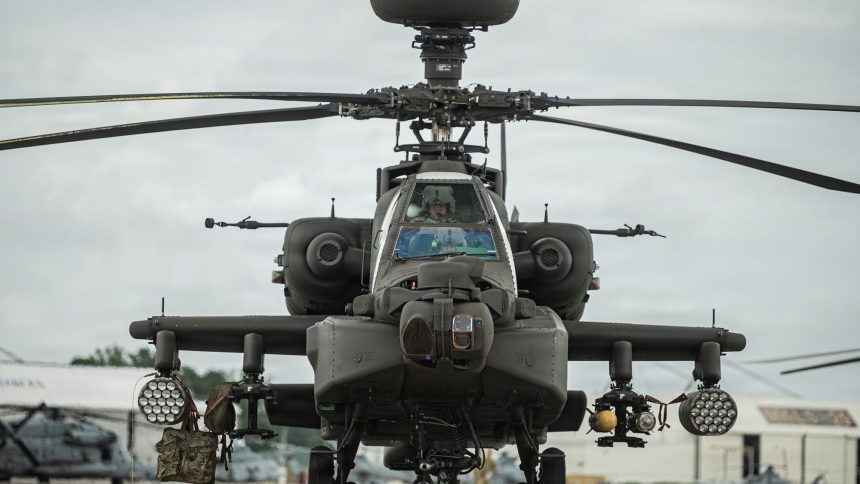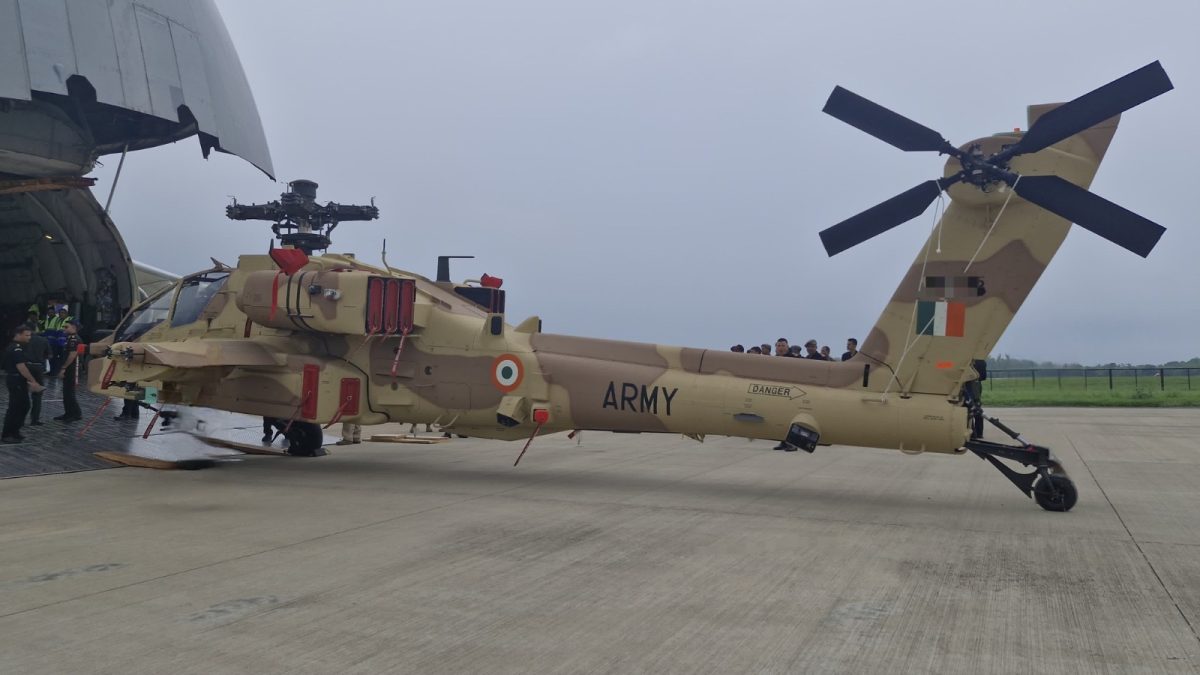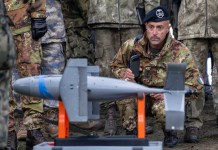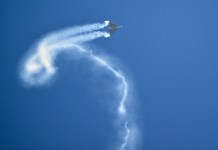The United States (US) Army is rapidly turning its combat-hardened attack helicopter, the AH-64E Apache, into a drone-killing machine.
During Operation Flyswatter, a one-of-a-kind counter-drone live fire exercise conducted at Marine Corps Air Station (MCAS) New River, N.C., the US Army’s AH-64E Apache helicopter demonstrated its ability to detect, track, and defeat unmanned aircraft systems (UAS), according to an official press statement published by the service on November 18.
Led by the Army’s Apache Project Management Office (PM Apache), the exercise involved Army, National Guard, Marine Corps, Navy, and industry partners. The main objective of the exercise was to validate Apache’s Version 6 (V6) software and weapons package against the rapidly evolving drone threat.
Version 6 is the most advanced configuration of the AH-64E, introduced as part of an ongoing modernization program to enhance the helicopter’s lethality, survivability, and interoperability in modern multi-domain operations (MDO).
The release did not disclose the exact date of the exercise.

The press release states that the mission profiles were flown by South Carolina Army National Guard (SCARNG) aircrew, who carried out detection and engagement scenarios against multiple UAS.
“We successfully achieved 13 kills out of 14 engagements, proving the Apache—using its current software and systems—is a lethal and adaptable solution to the drone threat,” said Chief Warrant Officer 5 Daniel York, PM Apache New Equipment Training (NET) Team Manager. “The Apache can engage both small and larger drones with a wide range of munitions, underscoring its operational flexibility and combat relevance.”
During the exercise, the AH-64E helicopters used the full range of Apache munitions, including the Joint Air-to-Ground Missiles (JAGM) that were guided by Fire Control Radar. It also used Radio Frequency (RF) and Semi-Active Laser (SAL) III Hellfire missiles using both radar and laser designations.
The helicopter carried Hydra-70 rockets with Advanced Precision Kill Weapon System (APKWS) guidance, which reportedly struck three of four UAS, showcasing incredible performance. Additionally, it featured 30mm M789 high-explosive dual-purpose rounds, which achieved close-range kills at under 300 meters.
The statement notes that the choppers engaged 14 targets and killed 13, showcasing a high degree of hit/kill probability.
This exercise demonstrated that Link 16 data sharing and radar cueing significantly reduce sensor-to-shooter timelines. Meanwhile, the operators also validated Apache’s ability to fight under weather and at low altitudes, where other platforms struggle.
“This demonstration reinforces the Apache’s continued role as a vital combat asset,” said the PM Apache New Equipment Training (NET) Team Manager, York. “As UAS threats proliferate, Apache crews are proving they can meet the challenge and remain at the forefront of Army aviation.
The US Army troops described the exercise as an overwhelming success.
“The Apache proved it can counter UAS with radar and laser-guided missiles, laser-guided rockets, and the 30mm—while leveraging both EO/IR [Electro-Optical/Infra-Red] and radar sensors. With Link-16 integration, it demonstrated it can operate as a true mobile air defense platform, filling a gap that ground systems alone can’t cover,” said CW5 Joel Gooch, State Standardization Pilot.
“The lessons from this exercise will drive new TTPs [tactics, techniques, and procedures] across Army Aviation. New training tasks are being developed and will soon be incorporated into requirements, ensuring counter-UAS remains a lasting and vital mission set for the Apache community,” he added.
The Boeing AH-64 Apache, designed in the 1970s as a premier anti-armor attack helicopter, has undergone significant modifications to counter UAVs. This shift comes as drone warfare gains prominence in modern battlefields, as seen in the Ukrainian War, where low-cost drones have neutralized high-value assets, including helicopters.
The use of attack helicopters in anti-drone operations is rapidly increasing. For instance, in October 2024, AH-64D Longbow Apache attack helicopter participated in ‘Red Sands Exercise’ with Saudi Arabia, where they were tasked with shooting down drones.
An AH-64 Apache helicopter was seen in a video attacking a hostile drone with the AGM-114 Hellfire missile, considered a first at the time.
. @USArmy Soldiers engage an unmanned aerial system (UAS) from an AH-64 with upgraded Hellfire missile during Red Sands training exercise in the Kingdom of Saudi Arabia. @usarmycentral pic.twitter.com/HG9ChuWxt6
— U.S. Central Command (@CENTCOM) September 30, 2024
There have been several instances of helicopters downing drones in real combat scenarios.
In March 2024, a French helicopter, either NH-90 or Eurocopter AS565 Panther (more likely), shot down a Houthi drone over the Red Sea in a rare air-to-air combat.
The Israeli military has also deployed the AH-64 Apache helicopter for neutralizing drones and for air defense roles. A video of an Israeli Apache helicopter intercepting a Hezbollah Attack drone near northern Israel was published in August 2024.
Video of an Israeli Air Force Apache helicopter shooting down a UAV (drone) infiltrating Israeli territory from Lebanon. #IsraelHezbollahWar pic.twitter.com/aX2qpEYLwh
— Eretz Israel (@EretzIsrael) August 12, 2024
In a separate incident, a Ukrainian serviceman downed a Russian Shahed-136 attack drone from a Mi-8 helicopter of the army aviation in August 2024. Meanwhile, a Russian Kamov Ka-52 helicopter shot down a Ukrainian drone using a Vikhr-1 anti-tank guided missile (ATGM) in October that same year.
Several such incidents have been reported across theatres in the past year.
The utility of Apache AH-64E helicopters in downing drones may be of interest to all its operators across the globe, including the Indian military, which has acquired the helos to counter China and Pakistan in high altitude regions.
The Indian Army is currently awaiting the delivery of the second and final batch of helicopters. Interestingly, Boeing attempted to deliver the second and final batch of helos to India but was forced to abandon it after Turkey refused to grant air clearance to the cargo aircraft.

AH-64E Apache Helicopters
The AH-64E Apache is “an advanced multi-mission helicopter with the latest technology insertions, maintaining its standing as the world’s best attack helicopter,” according to Boeing. It is the only combat helicopter on the market with a range of capabilities for almost any mission need, including increased lift and thrust, joint digital interoperability, enhanced survivability, and cognitive decision support.
The Apache AH-64E is a fourth-generation, twin-engine, tandem-seat, heavily armed, all-weather, day/night precision-strike platform that may be used for a variety of tasks, including armed reconnaissance, close air support (CAS), anti-ship, and anti-armor operations.
The AH-64E has a state-of-the-art avionics suite that is centered on the Lockheed Martin Arrowhead third-generation forward-looking infrared (FLIR) system and the AN/APG-78 Longbow millimeter-wave fire-control radar mounted above the main rotor. The Longbow can scan for low-flying, slow-moving UAS up to 8 km away, even in adverse weather or cluttered environments. It cues weapons autonomously, reducing pilot workload.
The AH-64E features a Link 16 data link that could facilitate real-time sharing of information, including UAS tracks, with ground forces, jets, or other Apaches, slashing sensor-to-shooter timelines from minutes to seconds.
This could turn the Apache into a “flying command node” for layered air defense.
The Apaches are designed as “tank killers” and armed with munitions capable of precision strikes against hostile armored units. They can effectively engage 16 targets simultaneously with their Longbow radar, which can identify and prioritize up to 128 targets in under a minute, making them useful in situations requiring a quick reaction against ground forces.
The US Army’s AH-64E Apache, long the gold standard for anti-armor strikes, is now evolving into a frontline counter-unmanned aircraft system (C-UAS) asset.
This adaptation is being rigorously tested and validated through live-fire exercises, leveraging the helicopter’s advanced sensors, networked capabilities, and multi-role weaponry, thus making it more lethal and valuable than ever before.
- Contact the author at sakshi.tiwari13 (at) outlook.com
- Follow EurAsian Times on Google News




